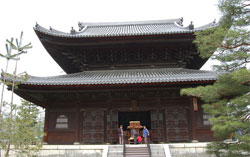Myoshin-ji, “Temple of the Wondrous Mind,” is the headquarters of the largest of the fourteen schools of Japanese Rinzai Zen Buddhism. It was established in 1337 by the cloistered emperor Hanazono (r., 1308–1318), who converted his country residence into a temple and asked his teacher, the Zen master Shuho Myocho (1282-1337), to suggest a suitable first abbot.

Shuho recommended his disciple Kanzan Egen (1277–1360), who was then doing post-enlightenment training in the mountains of Gifu Prefecture. Kanzan was formally invited, and returned to Kyoto to take the post of abbot. The emperor, following Shuho’s death, continued his Zen practice under Kanzan, commuting to Myoshin-ji from his residence at what is now the subtemple Gyokuho-in. Kanzan was renowned for the simplicity and austerity of his lifestyle.
After Kanzan’s death (said to have occurred while the master was standing by a tree, dressed in his pilgrimage clothes), Myoshin-ji went into a period of decline. For a time the name was changed to Ryu’un-ji, and the temple was placed under the control of Nanzen-ji. In 1432 the fourth abbot, Nippo Soshun (1368–1448), restored the temple buildings as well as the name Myoshin-ji. Not long thereafter Myoshin-ji was burned during the Onin War (1467–1477), but was rebuilt by Sekko Soshin. (1408-1486), the sixth abbot of the temple.
Following that time Myoshin-ji has prospered. The main buildings of the temple today were built during the later Muromachi period (1333–1568), when Myoshin-ji attracted the support of many of the country’s leaders. The temple precincts were expanded in 1509 through acquisition of property from the nearby imperial temple Ninna-ji. In the sixteenth century Myoshin-ji instituted the four-branch system of administering its subtemples; the four branches are the Ryosen-ha, Tokai-ha, Reiun-ha, and Shotaku-ha. Myoshin-ji grew substantially during the Meiji era (1868–1912), a period when the present administrative system was organized and the precursors of Hanazono University and Hanazono High School were established.
There are now forty-seven sub-temples within the Myoshin-ji compound, and more than three thousand affiliated temples throughout Japan. The temple precincts are laid out in the classical Zen monastic pattern, in which, starting from the south, the Sanmon (Mountain Gate), Butsuden (Buddha Hall), Hatto (Dharma Hall), and Hojo (Abbot’s Quarters) are aligned toward the north, with the Yokushitsu (Bath House), Kyozo (sutra library) to the east of this south-north axis and the Sodo (Monk’s Hall) to the west. Many of the buildings in Myoshin-ji are National Treasures or Important Cultural Properties. The temple bell (the oldest in Japan, cast in 698) is also a National Treasure, as are many of the paintings, hanging scrolls, sliding screens, and other art treasures in the possession of Myoshin-ji and its subtemples.
Source
Joint Council for Rinzai and Obaku Zen
Mountain Name
Shobozan.
Address
64 Hanazono Myoshinji-cho, Ukyo-ku, Kyoto-shi, 616-8035 Japan.
Tel: 075-461-5226 | Fax: 075-464-2069



